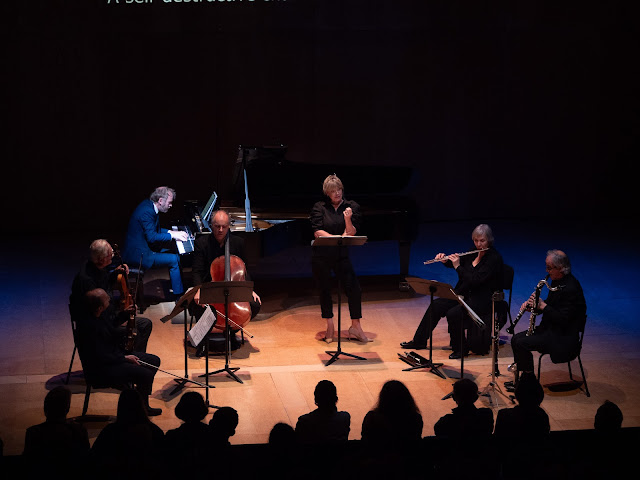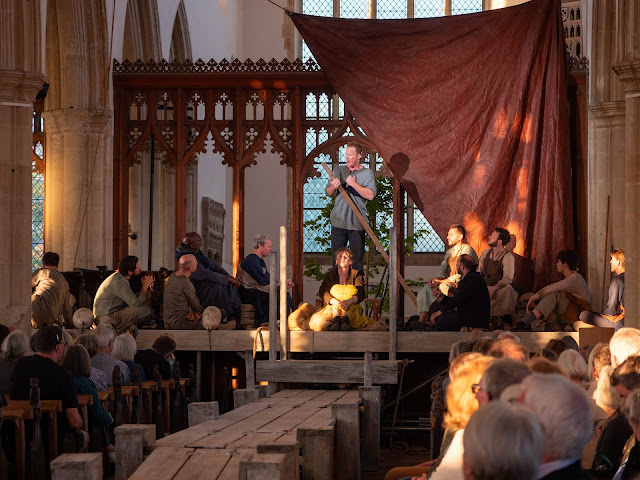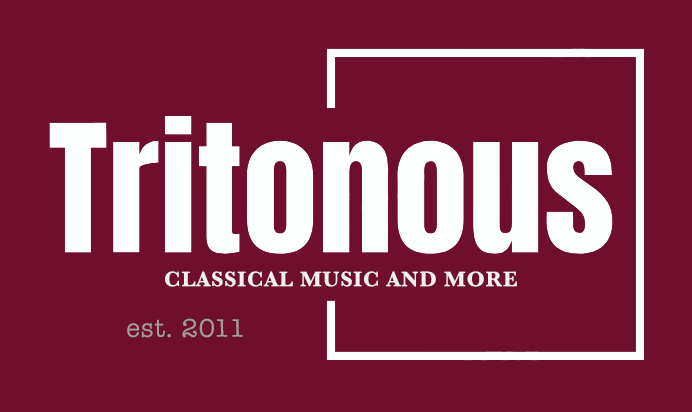 |
| Schoenberg: Pierrot Lunaire – Claire Booth, the Nash Ensemble – Aldeburgh Festival (Photo: Marcus Roth, (c) Britten Pears Arts) |
Schoenberg: Pierrot lunaire, Beethoven, Julian Anderson, Judith Weir, Mozart; Claire Booth, The Nash Ensemble, Martyn Brabbins; Aldeburgh Festival at Britten Studio
Britten: Curlew River; Ian Bostridge, Duncan Rock, Peter Brathwaite, Willard White, Matthew Jones, Deborah Warner, Audrey Hyland; Aldeburgh Festival at Blythburgh Church
Britten: Suite from Death in Venice, Mahler: Symphony No. 5; The Hallé, cond. Sir Mark Elder; Aldeburgh Festival
Reviewed by Tony Cooper (25 June 2024)
This year’s Aldeburgh Festival has reached new limits with a roster of excellent concerts and recitals not least by the tasteful musical feast served up for the last weekend.
A cycle of 50 poems, Pierrot lunaire was published in 1884 by Belgian author, Albert Giraud (born Emile Albert Kayenbergh in Leuven in 1860) closely associated with the Symbolist Movement who wrote poems in French. The protagonist of the cycle, Pierrot – the moonstruck and fantastical clown who wears a mask to hide one’s true feelings – is the well-loved comic servant and ‘outsider’ of the Italian Commedia dell’Arte theatrical tradition. Early 19th century Romantics, such as Théophile Gautier, were drawn to him by his Chaplinesque pluckiness and pathos.
Therefore, remarkable in many respects, Giraud’s collection is among the most densely and imaginatively sustained works in the ‘Pierrot’ canon which attracted the attention of an unusually high number of composers but it’s Schoenberg’s setting that’s the most renowned and widely considered one of the landmark masterpieces of 20th-century music. Although the composition is atonal, it’s not written in the twelve-tone technique that Schoenberg developed (and favoured) in his later years.
The commission came from Albertine Zehme, a chanteuse married to a Leipzig lawyer, asking Schoenberg to set a lecture text to music. Completely free in the selection of poems, his choice was, of course, the French cycle of poems of Pierrot lunaire by Giraud translated by Otto Erich Hartleben. Selecting 21 poems from the cycle, Schoenberg duly divided them into three distinctive groups: in the first (Drunk on the Moon, Colombine, The Dandy, A Pale Washerwoman, Valse de Chopin, Madonna, The Sick Moon Pierrot) Pierrot sings of love, sex and religion; in the second (Night, Prayer to Pierrot, Robbery, Red Mass, Gallows Song, Beheading, The Crosses) he sings of violence, crime and blasphemy; in the third (Homesickness, Foul Play, Parody, The Spot on the Moon, Serenade, Journey Home, O Ancient Fragrance) Pierrot dreams of returning home to Bergamo with his past haunting him.
At the work’s première in 1912, the ensemble comprised Albertine Zehme (voice) with Hans W. de Vries (flute), Karl Essberger (clarinet), Jakob Malinjak (violin), Hans Kindler (cello) and Eduard Steuermann (piano). According to Anton Webern, the première was a great success for performers and Schoenberg but received a bad press although most of the audience, fascinated by the new sounds, responded reasonably well to the performance overall.
 |
| Britten: Curlew River – Aldeburgh Festival (Photo: Marcus Roth, (c) Britten Pears Arts) |
But Pierrot lunaire at the Rudolfinum, Prague, on 24 February 1913, caused uproar and mayhem with the audience becoming one of Schoenberg’s most frightening and traumatic experiences which he remembered for the rest of his life, leading him to demand guarantees for trouble-free performances at further ‘Pierrot’ concerts. The première of Stravinsky’s The Rite of Spring performed by Diaghilev’s Ballets Russes at the Theatre du Champs-Élysées, Paris, appeared two months after Schoenberg’s Pierrot lunaire, widely considered the most notorious scandal in the history of music, mirrors the same scenario.
Thankfully, no one had angst or anger etched into their faces at the Aldeburgh Festival in such a brilliant and effortless performance delivered by Claire Booth with the performance nicely sandwiched between Thursday’s Solstice (20 June) and Saturday’s Full Moon (22 June) and coinciding, too, with the anniversary of Peter Pears’ birthday. Heard in the intimacy and comfort of the Britten Studio (ideal for works such as Pierrot lunaire) the players of The Nash Ensemble – Philippa Davies (flute), Richard Hosford (clarinet), Benjamin Nabarro (violin), Lars Anders Tomter (viola), Adrian Brendel (cello) and Alasdair Beatson (piano) – were found on top form. Are they ever off it?
Schoenberg’s instrumentation is innovative and stylish to the core as he uses a different pairing for each number apart from the last when the full ensemble comes together. Schoenberg also employs the use of ‘sprechstimme’ (‘speech-voice’) frequently used in 20th-century music and so closely associated with his compositions. He first used the technique in Pierrot lunaire although it was used by Engelbert Humperdinck a few years earlier in his melodrama, Königskinder, in 1897.
A remarkable and internationally-renowned singer and perfect for Schoenberg, Claire Booth has just issued a couple of recordings marking the 150th anniversary of the composer’s birth namely Pierrot lunaire and Expressionist Music: A Schoenberg Songbook (generously supported by the Schoenberg Centre, Vienna) pairing Schoenberg’s songs with eight of his own paintings taking its cue from the composer’s statement that ‘painting is the same to me as making music’. Mendelssohn, a gifted watercolourist, felt the same way, too. On a trip to Switzerland in 1838, he wrote to his life-long friend, Carl Klingemann, revealing that he had composed not even a bit of music but sketched and drew entire days to his heart’s content!
Staying over for a further concert on the final Saturday of the festival (22 June), Claire Booth and The Nash Ensemble offered an attractive programme conducted by Martyn Brabbins comprising Beethoven’s Clarinet Trio in B flat, Op.11, Julian Anderson’s Three Songs, Judith Weir’s Distance and Enchantment and Mozart’s Piano Quartet No.1 in G minor.
Scored for the rare combination of clarinet, cello and piano, Beethoven’s Clarinet Trio, a work of expansive and genial elegance, provided a good ‘opener’ for a late-morning concert in the Britten Studio. Composed in 1798, just before Beethoven turned his attention to his first set of string quartets, the work found great favour with a packed house with the sprightly and tuneful last movement ending a nice playful and lyrical piece. Comprising variations on ‘Pria ch’io l’impegno’(‘Before I begin this task, I need a snack’) from Joseph Weigl’s comic opera, L’amor marinaro, which was all the rage in Vienna in 1797. Beethoven was quick off the mark to cash in on it!
Julian Anderson’s Three Songs so well-suited Claire Booth’s voice. They were simply delightful. A 12-minute work, the first song, ‘le 3 mai’, set to a text by Ahmed Essyad, written in 2020, focuses on the Covid-19 social restrictions with a brilliant satirical-like line ‘I embrace you all, this kiss is pure, without Covid’; the second ‘Tombeau’, set to a text by Stéphane Mallarmé, commissioned by the Birmingham Contemporary Music Group in 2017 for a celebration of the music of Debussy in 2018, was pure delight; the third, ‘THUS’, a setting of the last verse of Henry Longfellow’s poem, Rain in Summer, had members of The Nash Ensemble adding percussive sounds to the performance by heavily stamping their feet hard on the boards of the stage (as part of the score, of course!) at the same time as playing their instruments with Anderson employing a bass clarinet thus adding an extra dimension to the overall mood of the piece.
In Judith Weir’s Distance and Enchantment, the composer sums up her piece as a musical essay about people who suddenly disappear from home never to return, a strikingly common occurrence nowadays. But what is not such a common occurrence is a sudden break in performance. Just a few minutes into the piece, Adrian Brendel had a fright (the audience, too, to a certain extent!) as he was up-and-ended when the piano stool he favours for performance collapsed – maybe under the strain of Mozart! Shades of the British rock group, The Who, who would smash to smithereens stuff and the like at the end of their performance.
However, picking himself up from the floor, checking that no damage was done to his cello, unfazed and to a big round of applause, he gingerly took to his new seat (Aldeburgh’s stage crew were quick off the mark!) and the performance restarted as if nothing had happened. Judith Weir, one of the composers-in-residence at this year’s festival, attended the concert. I wondered what passed through her mind.
Anyhow, Distance and Enchantment takes the form of two meditations on traditional folksongs played together without a break handsomely performed by the pianist and string trio of The Nash Ensemble. A brilliant lot, really! Therefore, ‘The Dark-Eyed Gypsy’ from Northern Ireland tells of a woman who, of her own volition, leaves her comfortable home to roam the unknown world with a band of gypsies while in ‘A Ghaoil, Leig Dhachaigh Gum Mhàthair Mi’ from South Uist, Scotland, the story surrounds a young girl who wanders a little too far from home on a dark night and is stolen away by the fairies.
Harbouring a passionate charm, Mozart’s Piano Quartet No.1 has delighted audiences time and time again and more than delighted the packed house in the Britten Studio. The first movement opens with a stern musical ‘call to order’ by all four instruments playing in unison with the second movement comprising a beautifully-expansive melody filled with a quiet dignity and a tinge of sadness seemingly transporting one to a shimmering and intimate scene from one of Mozart’s operas while in the fast and final movement, Mozart moves one into the brightness of the day thus bringing the quartet to a fitting conclusion filled with endlessly inventive melodies, joy and warmth that is, I guess, the composer’s trademark!
The first of Britten’s three ‘Parables for Church Performance’, the scenario of Curlew River is based on Kanze Motomasa’s sad and emotional play, Sumidagawa, a hauntingly-moving story about a mother’s search for her long-lost son who nervously finds out that after he has been abducted he’s later found dead. A fascinating story, Britten saw it a couple of times during his visit to Japan with Peter Pears in early 1956 in Tokyo’s Suidobashi Noh Theatre while Britten’s librettist, William Plomer, who lived in Japan during the 1920s and who encouraged Britten to explore Japanese theatre, transferred the traditional setting of this 15th-century play to the medieval Fenlands of East Anglia thereby presenting it as a Mystery Play.
A major undertaken for Britten, he decamped to Venice for six weeks to work on Curlew River finding this city (lovingly dubbed ‘La Serenissima’) one of the few places other than Suffolk where he felt relaxed enough and in the right environment to compose. On its first performance in Orford parish church, dedicated to St Bartholomew, at the 1964 Aldeburgh Festival, the critic of The Times described Curlew River as ‘possibly the start of a new, perhaps the most important, stage of Britten’s creative life’. Completing the Noh trilogy are The Burning Fiery Furnace (based on the Old Testament story of Nebuchadnezzar and the three Israelites) and The Prodigal Son (based on the parable from St Luke’s Gospel).
Directed by Deborah Warner, assisted by Isabelle Kettle, this new staging at Blythburgh church, dedicated to the Holy Trinity and suitably dubbed the ‘Cathedral of the Marshes’, is a co-production with Britten Pears Arts and Ad Lib Productions and one of the highlights of the 75th Aldeburgh Festival which has been a runaway success from start to finish.
Interestingly, there’s no conductor in the presentation of Noh drama. Britten, of course, was music director for the original production with pianist Viola Tunnard working alongside him while Peter Pears took the lead role in each work. Scored for small instrumental forces and an all-male cast, Britten makes great use of musical symbolism in Curlew River such as employing a flute to represent the ‘Madwoman’ and a French horn, the ‘Ferryman’.
Blythburgh church is ideal for such presentations as Curlew River and I fondly recall seeing a staging of the complete Noh trilogy here by Mahogany Opera, directed by Frederic Wake-Walker, in 2013, the year celebrating the centenary of Britten’s birth. The cast was headed by tenor Mark Padmore with the Aurora Orchestra and Roger Vignoles as music director. In fact, I also had the pleasure of attending the world première of the Noh trilogy at Orford church in 1964 by the English Opera Group directed by Colin Graham and, indeed, later at the Edinburgh Festival in St Mary’s Cathedral in 1968 when the festival director, Peter Diamand, focused on the music of Schubert and Britten.
Incidentally, Wake-Walker was brought up in Suffolk where, as a treble, he sang in three Britten operas at Snape Maltings including, at the age of 11, Miles in The Turn of the Screw. Now a challenging and futuristic director and producer of opera and contemporary music-theatre, Wake-Walker’s renowned for his ground-breaking work at major international opera-houses and in unconventional spaces, too. He was awarded Best Director at the 2019 Opera Awards for his productions of Peter Grimes (Oper Köln) and Ariadne auf Naxos (La Scala, Milan).
Celebrating its 60th anniversary this year, Curlew River was admirably led by Ian Bostridge as the Madwoman with Duncan Rock (Ferryman), Marcus Farnsworth (Traveller), Matthew Jones (Spirit of the Boy/Acolyte), Daniel Harrison (Spirit of the Boy/Acolyte), Albert Bate (Acolyte), Willard White (Abbot/Leader of the Pilgrims) with the Pilgrims coming from the Chorus of Britten Pears Young Artists comprising Thomas Elwin, Thomas Herford, Hugo Brady, Jonathan Eyers, Felix Kemp, Jolyon Loy, Francis Brett, Jack Comerford while a group of seven instrumentalists – Hannah Gillingham (flute/piccolo), George Strivens (French horn), Luca Wadham (viola), Lucía Moreno (double-bass), Miriam Keogh (harp), Ryan Hepburn (percussion) and Joseph Ramadan (chamber organ) – came from the Britten Pears Young Artist Programme, led by Audrey Hyland, who, incidentally, was staff pianist on BPYAP courses, a role first undertaken by Viola Tunnard.
Casually dressed in their day-to-day clothes, T-shirts, jeans and the like, Curlew River solemnly opens with group of Monks gathering at the back of the church in order to ceremonial process along Blythburgh’s long and imposing nave under the gaze of a host of elegantly-carved wooden angels with outstretched wings, chanting the plainsong ’Te lucis ante terminum’ (‘To Thee before the close of day’) an old Latin hymn (which also opens the other two works in the Noh trilogy) before robing in front of the chancel to enact the Mystery Play.
In fact, most of the stage action was centred upon the nave and Blythburgh has an extended nave to many of its neighbouring churches therefore I felt that Deborah Warner’s production worked well in such an intimate and confined space while the musical forces found space in the south aisle by the chancel. At the work’s première the instrumentalists comprised Richard Adeney (flute), Neill Sanders (French horn), Cecil Aronowitz (viola), Stuart Knussen (double-bass), Osian Ellis (harp), Philip Ledger (chamber organ) and James Blades, percussion, comprising five small untuned drums, five small bells and one large-tuned gong.
A small, exceptional and gifted cast was led by Ian Bostridge as the Madwoman. Shabbily dressed in a lemon-green dress and dark jacket, a broken umbrella is held in one hand and seemingly wandering as a ‘homeless’ person, this rather sad and confused character is travelling with a rather worn and well-used duvet. Grief-stricken, agitated and distressed, looking for her long-lost son took its toil with the role (created for Peter Pears) vividly portrayed by Bostridge who played the part to the full delivering an honest and convincing account while his acting abilities handsomely matched his vocal prowess.
Roughly dressed, wearing an anorak, the storyteller in the pack, Duncan Rock, brilliantly portrayed the Ferryman (written for John Shirley-Quirk) while the strong deep bass voice of Willard White stamped his authority on the role of Abbot/Narrator thereby strengthening and enriching the Christian dimension of this compelling piece of Noh theatre. Although harbouring rich and diverse religious influences nowadays the Noh tradition is predominantly an artistic and literary form that has moved miles away from its religious/ritual origins. The cast was completed by Marcus Farnsworth putting in a comfortable and rewarding performance as The Traveller (written for Bryan Drake) who, describing his nomadic life, has intentions to cross the Curlew River.
However, the most poignant moment in the whole of this intense and captivating drama surrounds the Ferryman’s story where it’s abundantly clear that the boy he’s describing is the child of the Madwoman. Broken-hearted, she joins in prayer at her son’s graveside on the far bank of Curlew River and at the climactic moment when all the Monks are chanting together, the Spirit of the Boy (sung offstage by Matthew Jones, acted onstage by Daniel Harrison) is heard echoing them with his spirit glowing above the tomb to reassure his mother: ‘Go your way in peace, mother. The dead shall rise again. And in that blessed day. We shall meet in heav’n.’ At this point, the Madwoman is redeemed, her madness lifts which is lovingly depicted in a deep and moving scene with her singing a joyful and colourful ‘Amen’ with the full cast joining in signalling a sign of return and acceptance.
The quiet and dignified ending is punctuated by the return of the robing music while the chorus of eight pilgrims resume their day-to-day attire singing plainsong as they process along the nave towards the west end of the church thus mirroring the start of the performance. A truly memorable production that received a standing ovation from an adoring audience.
The performance was recorded by BBC TV for future broadcast in a film by Ad Lib Productions directed by Dominic Best.
The final ‘shout’ of Aldeburgh’s 75th Festival gloriously opened with Britten’s Suite from Death in Venice arranged in 1984 by Steuart Bedford, a close associate of the composer, in a well-controlled performance of elegance and tenderness by the Hallé under Mark Elder. Stuart Bedford, in fact, conducted the opera’s première at the 1973 Aldeburgh Festival. A continuous orchestral work, it could well be described as an ‘operatic symphony’ and the score flows smoothy and logically through the salient points of the opera’s scenario falling into seven clearly distinct and recognizable sections: Summon to Venice; Overture to Venice; First Beach Scene; Sight of Tadzio; Pursuit; Second Beach Scene; Death.
In stark contrast to the lightness and melancholic score to Death in Venice, the Hallé turned their attention to one of the big guns of 19th-century music, Gustav Mahler, delivering a fine rendering of the composer’s mighty fifth symphony written over the summers of 1901-02 at the composer’s holiday retreat at Maiernigg near Maria Wörth, Carinthia, Austria.
Written in three parts and comprising five movements, the ‘adagietto’, the shortest movement lasting about 10 minutes, found universal popularity when Luchino Visconti used it in his 1971 film, Death in Venice. An immensely lyrical and evocative piece so endearing with emotional and passionate outbursts, Mahler supposedly wrote it to represent his love for his ‘soon-to-be wife’ Alma.
A grand and imposing work, the symphony received its première in Cologne’s equally grand and imposing Gürzenich Hall conducted by the composer but this Aldeburgh Festival performance by the Hallé, conducted by Sir Mark Elder, proved a grand and imposing occasion, too, and brought the curtain down on a highly successful festival which sees Sir Roger Wright, CBE, bow out of his post as Chief Executive of Britten Pears Arts on a high after serving a glorious decade at the helm.
And to mark Roger’s parting, Sir Mark Elder offered the audience a fitting encore in his honour with the strings of the Hallé delicately playing a gentle rendering of Elgar’s Chanson de Nuit thus mirroring the opening concert of the festival when the brass and percussion of the London Philharmonic blasted Snape Maltings Concert Hall with a thoroughly enjoyable Fanfare in Roger’s honour penned by Colin Matthews. The only difference being that ‘the-man-of-the-moment’ then was just Roger Wright – by the end of the festival he became Sir Roger Wright. Congratulations!
Never miss out on future posts by following us
The blog is free, but I’d be delighted if you were to show your appreciation by buying me a coffee.
Elsewhere on this blog
- Youthfully engaging: a visually stylish new Rake’s Progress at the Grange Festival made us really care for about these characters – opera review
- A richly layered depiction of characters in all their fallibility: Monteverdi’s L’incoronazione di Poppea at the Grange Festival – opera review
- The Sea and Ships: the London Song Festival celebrates the first Shipping Forecast to be broadcast on British radio – concert review
- Much more than a piece of history: Roderick Cox conducts Shostakovich’s Symphony No. 10 at the Royal Academy of Music – concert review
- Music like no other: Icelandic composer Gudmundur Steinn Gunnarsson’s Stífluhringurinn – record review
- New colours in old sound worlds: the Portuguese duo, Bruno Monteiro & João Paulo Santos in Elgar, Debussy, Ravel & more – record review
- Time remembered: the 75th edition of the Aldeburgh Festival lovingly recreates the opening night of 1948 Festival – concert review
- A disc that makes you think, but also satisfies as a recital in its own right: Songs for Peter Pears from Robin Tritschler & friends – record review
- Second view: Anna Patalong makes her role debut as Puccini’s Tosca at Opera Holland Park – opera review
- An undeniable gift for melody: Charles Mauleverer’s Overture – record review
- Home


%20Britten%20Pears%20Arts%20(3).jpg?w=998&resize=998,665&ssl=1)





